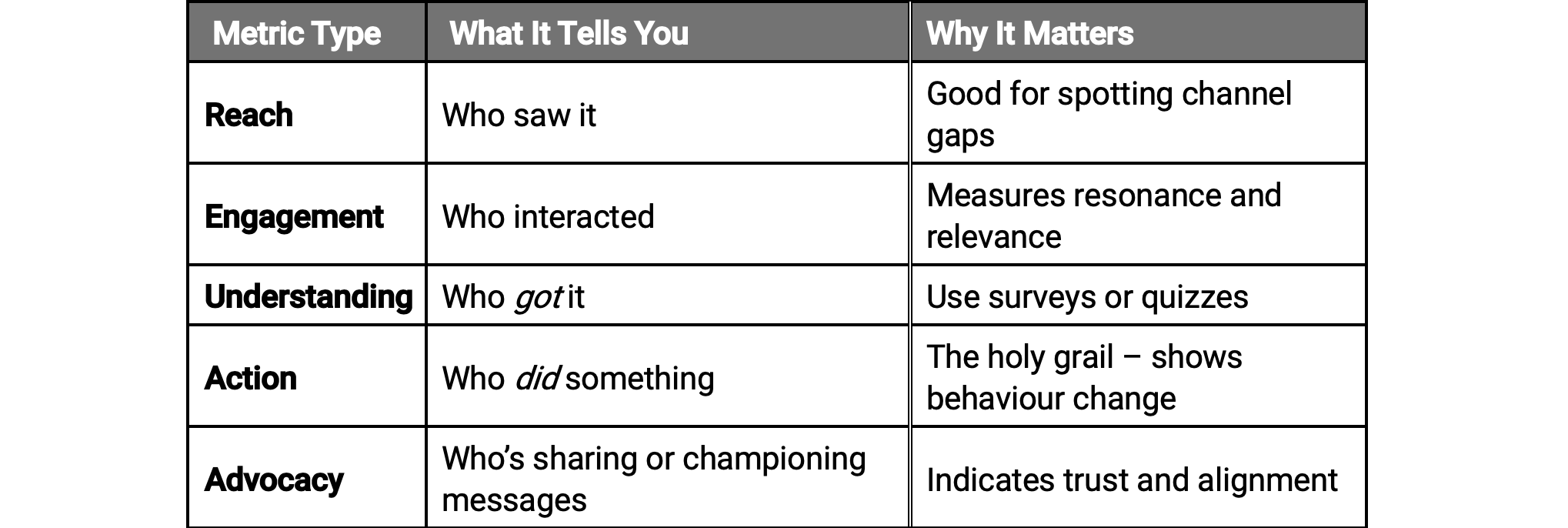Mobile, Hybrid, Desk-less: Why Your Internal Videos Need to Work for Everyone (And How to Do It)


Let’s be honest, most of us don’t get into Internal Comms because we love spreadsheets. We got into it because we like people, stories, culture, connection and a bit of creativity. Not conditional formatting.
But then someone (usually wearing a finance badge or clutching a dashboard) says those dreaded words:
“Can you prove ROI?”
Cue the sound of a thousand comms pros sighing into their oat lattes.
We’ve all done it. Counted clicks, tracked opens, stared blankly at a bar chart wondering what it actually means.
Those are activity metrics. And while they tell you what happened, they don’t tell you if it worked.
According to Gallagher’s State of the Sector 2024 report, 56% of comms teams still struggle to measure the impact of their internal communications in any meaningful way.
The result? Lots of data, little insight, and a creeping sense that your beautifully written all-staff update just got reduced to a number in column G.
Before you measure anything, ask:
“What do we want people to think, feel, or do differently after this?”
If your goal is to drive understanding of a new strategy, then clicks on the intranet article don’t matter as much as whether employees can articulate that strategy back.
Guru Tip: Align your comms goals with business goals. “We want 80% of people to understand the new direction” beats “We want 80% of people to open the email.”
Need help setting those goals? Our Comms Strategy services help you connect the dots between message and meaning.
Quantitative data (clicks, views, engagement rates) tells you what happened.
Qualitative feedback (surveys, focus groups, sentiment analysis) tells you why it happened.
Combine both and you get real, meaningful insight.
For example:
“Engagement on the new CEO video dropped by 50% halfway through.” That’s your quant.
Feedback says “It felt scripted and stiff”. That’s your qual.
Solution: Make the next one shorter and more human.
If you need help getting your all-important videos right, you could always ask for a bit of help.
Case in point: When Microsoft revamped their internal comms using employee feedback loops, they saw a 38% increase in perceived transparency within six months.
Here’s a cheat sheet of what actually matters:

And remember: if it’s not linked to a business outcome, it’s just trivia.
You don’t need to send your exec team a 30-slide deck full of pie charts.
Make your reporting visual, concise and story-led.
Use infographics, dashboards, or even short videos to share highlights.
Real-world example: Virgin Media O2 uses “Comms Health Dashboards” - one-page visuals combining data with human quotes. It’s digestible, colourful, and way more engaging than a spreadsheet parade.
Need a hand designing something that doesn’t put people to sleep? Start with an Internal Comms Health Check to review your metrics and show you exactly what to track (and what to ditch).
Internal comms isn’t a one-and-done deal; it’s an ongoing loop.
Celebrate what’s working, share wins widely, and tweak the rest.
Small example: If your weekly digest consistently gets high engagement, maybe it’s because it uses plain language, or features “real humans” instead of execs. Bottle that magic and sprinkle it liberally elsewhere.
Or if everyone avoids your intranet like the plague… maybe it’s not them. Maybe it’s the intranet. (Don’t worry, we’ve all been there.)

You don’t need 50 KPIs. You need the right five.
Measure what matters, tie it to real outcomes, and tell the story behind the stats.
Because great internal comms isn’t about proving value with numbers, it’s about creating value with clarity, connection, and trust.
At the end of the day, internal comms is about people. The numbers are just there to help you tell a better story.
So, if you’re staring at a spreadsheet wondering whether anyone actually feels your messages, take a breath. You don’t have to figure it all out solo.
We’re humans too (friendly ones, too, we’re told!), and we love teaming up with fellow comms pros to make sense of the noise, find the story in the stats, and bring internal comms back to life.
Let’s roll up our sleeves together and turn metrics into momentum.


